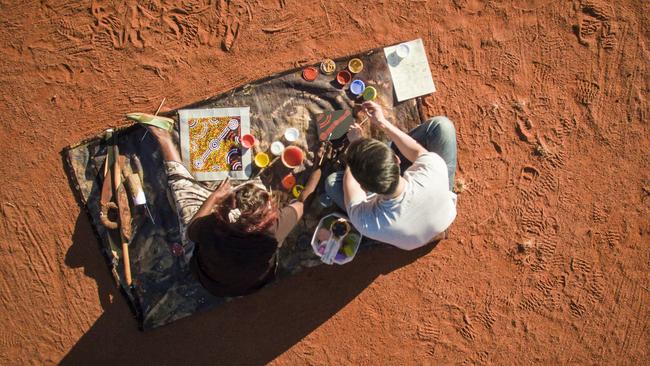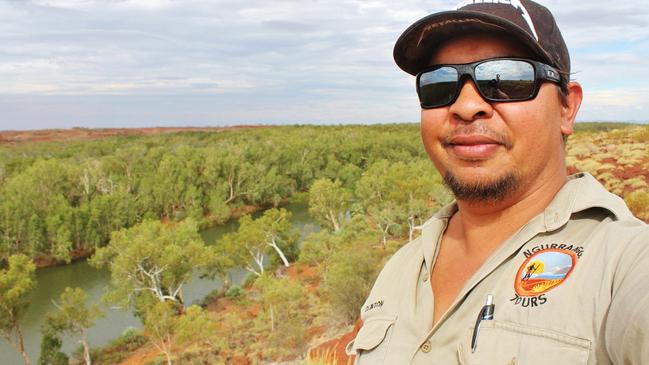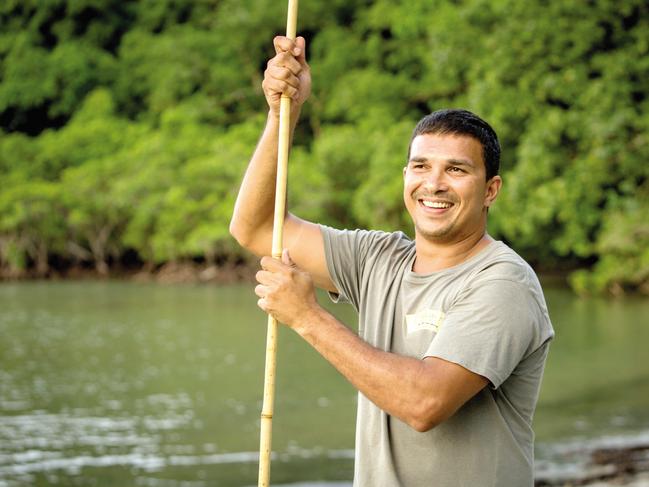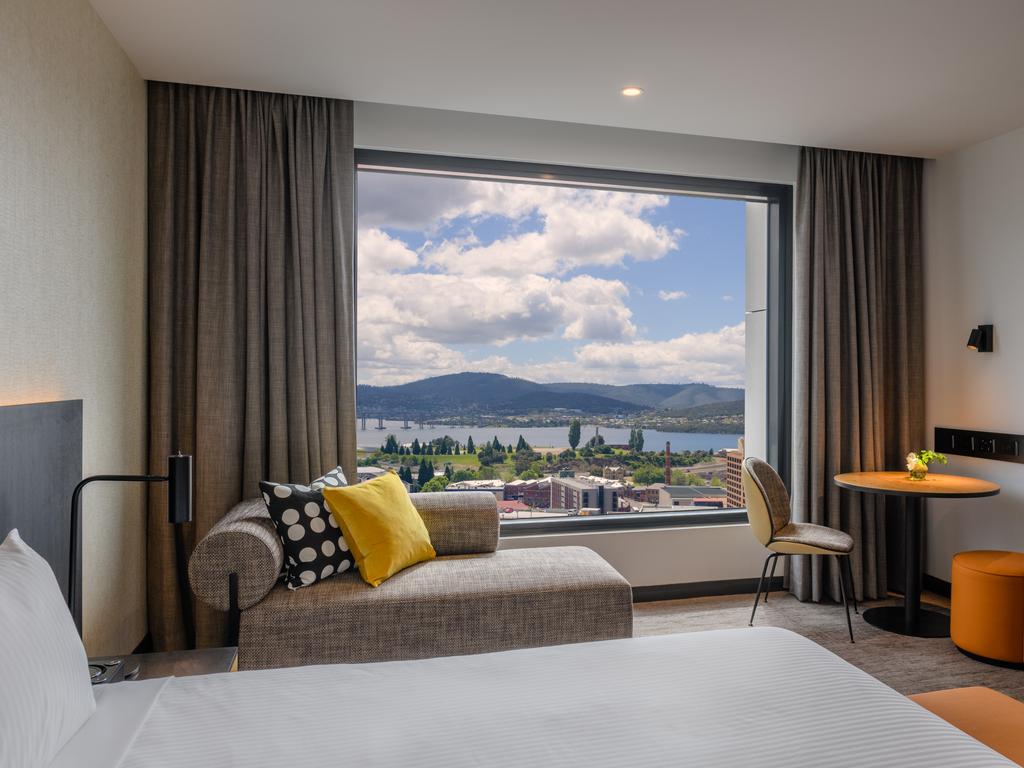Indigenous tourism: how to connect with country
With domestic travel the focus for the foreseeable future, Indigenous tourism is on the rise.

Within Bouddi National Park, on a hilltop we think is all about the view across the vast mouth of the Hawkesbury, Aboriginal guide Tim Selwyn sets two tweens and a teen a challenge. Can they search that spot over there and find something on the ground?
The kids are enthusiastic, zigzagging over the rocks while our eyes occasionally drift to Sydney’s Barrenjoey Lighthouse standing sentinel in the distance. Selwyn tries to help them. “Hot!” he yells. “Cold! Warm!” They are, it turns out, looking at but not seeing the shape of a wallaby chipped into the sandstone with tools thousands of years ago.
Selwyn is here to open our eyes to Aboriginal Australia. This means tuning in to the landscape, noting the traces of what was written on it long ago and pondering what these things might have meant. During the course of three hours, he will show us new ways of seeing, listening, thinking and feeling, punctuated with spine-tingling song, all while imparting gentle lessons about respect to the youngest participants. Our eyes will be ringed with ochre, transforming us into owls. “This gives you powerful eyes so you can see things and be a boss,” he says to one child while daubing the white ochre. “Not bossing people around but leading by example.”

Selwyn’s Girri Girra Aboriginal Experiences is one of 14 operators offering Aboriginal cultural outings in NSW national parks, supplementing a program of ranger educational tours. These excursions are part of what is a burgeoning nationwide industry. There are hundreds of ways to dive into Australia’s Aboriginal culture, from screen-printing tea towels on the Tiwi Islands, creating a dot-painting in central Australia and hunting for mud crabs in the salty shallows of far north Queensland. Some tours are serious, some light-hearted and some come with a built-in adrenalin surge, but all will teach you about Australia’s ancient culture.
‘Today’s conscious traveller is … seeking out life-changing and immersive experiences that are so perfectly suited to the experiences that our Aboriginal and Torres Strait Islander tourism businesses provide’
More than 170 of these tours, the creme de la creme if you like, are part of Tourism Australia’s portfolio of Discover Aboriginal Experiences. Before the crises of 2020 came along, more international visitors — 1.4 million in 2019 — signed up for an Aboriginal tourism experience than domestic travellers (one million). Interest from locals, though, had been growing strongly, with participation increasing 13 per cent a year since 2013 (compared with 6 per cent growth a year since 2010 from overseas visitors).
Tourism Australia managing director Phillipa Harrison says: “Australia’s rich cultural heritage of its Aboriginal people, which spans at least 60,000 years, is something that truly sets our country apart from other destinations around the world.

“With international travel on hold, we’re really encouraging Australians who have the means to do so to get out and explore more of their country and also immerse themselves in some of the incredible experiences our tourism operators have to offer.
“Today’s conscious traveller is increasingly looking for a sense of real connection from their travel experiences. When they travel they’re seeking out life-changing and immersive experiences that are so perfectly suited to the experiences that our Aboriginal and Torres Strait Islander tourism businesses provide.”
Last month, along came an initiative that made it even easier for travellers to book these experiences. Welcome to Country is a not-for-profit online marketplace for more than 100 Aboriginal and Torres Strait Islander experiences, some of them new, and 1000-plus products such as books, fashion and jewellery. After a soft launch in the Northern Territory in late 2019, the platform, which is all about creating economic empowerment for Aboriginal communities, rolled out across the nation.
Welcome to Country chief executive Jason Eades says: “We’re trying to amplify the marketing on these great tours and products. Over time there has been more interest in exploring and finding out things [about Aboriginal culture but] it’s fair to say people’s interest really spiked during [the 2020 Black Lives Matter movement].”
The coronavirus pandemic has also “in some ways been very positive because it pushed us to pause and think about our own country in a different way”. The isolation many Australians experienced last year created “a hunger for connection that I think we’ll see more of”, Eades says.

There’s probably no better example of this craving than when Welcome to Country launched a virtual yarn with Mutti Mutti elder Uncle Vince Ross. His fascinating life story starts with growing up on the banks of the Murrumbidgee River, moving into a house with water and electricity for the first time at age 18, and founding the Narana Aboriginal Cultural Centre in Geelong. “We sold out the first session with him within four hours of listing it,” says Eades.
Listening and learning can yield more than connection; it can mean survival. In Sydney’s Royal Botanic Garden, the place where Europeans first cleared native land, I examine clumps of lomandra, or mat rushes, with Renee Cawthorne, manager of First Nations education and engagement. It turns out just about every part of this hardy plant is useful. You can fish with it, weave it, turn the seeds into damper and rehydrate by chewing on the pale juicy stems of the long blades.

All this knowledge is gleaned from the garden’s Aboriginal heritage tours, also on the Welcome to Country platform. Since arriving at the garden in September, Cawthorne has helped develop new experiences, including a thrice-weekly cultural sunset tour that launches this month. There are also plans for Shared Knowledge, an entity offering bush food morning teas and lunches at the garden’s Victoria Lodge, to launch a Friday sunset cocktails and canapes experience. “A lot of people think you have to go to Uluru to have a First Nations experience but you can have one here in the middle of the city,” says Cawthorne, picking up a banksia flower from the ground to show how it’s a useful hairbrush.
“First Nations science is something that’s starting to be recognised. I really try to put across the ingenuity that was required to make fish traps and dams and weirs.”
Both Cawthorne and Selwyn choose words and phrases carefully — should we say Dreaming or Dreamtime, mob or clan, yidaki or didgeridoo? — and go to lengths to explain why they prefer one over the other in the hope non-Indigenous Australians come to see the country and its history as they do.
As Selwyn points to a leatherjacket carving and asks us to ponder if the tiny fish connects along a songline back to that wallaby, he says: “This is not rock art. These are learning spaces. They’re our universities.”
Katrina Lobley was a guest of NSW National Parks and Wildlife Service and the Royal Botanic Garden Sydney.
MORE TO THE STORY
Other ways to connect with Indigenous culture:
Look sharp

Kuku Yalanji man Juan Walker makes it look easy but, as first-timers will discover, spearing a scuttling mud crab is harder than it looks. Pick up a weapon and stalk the shallows north of Port Douglas with Walker, who entwines ancient stories with 21st-century life. In northern NSW’s Terranora Lakes mangrove system, hunt for muddies with Yugambeh man Luther Cora during a weekly Pot to Plate cruise; walkaboutadventures.com.au; tweedecocruises.com.
Join the dots
At Voyages Ayers Rock Resort, sit with an Anangu artist and learn the meaning of commonly used symbols in dot painting before using this knowledge to paint your own story. On the Tiwi Islands, see the stunning altar of a church that combines Christianity with Dreaming stories before creating your own screen print at the art centre; ayersrockresort.com; sealinknt.com.au.
Look and learn
Gain an insight into the pre-colonisation Nyoongar nation during a new Perth walking tour that explores the shores of the Swan River, Matagarup Bridge and the Optus Stadium precinct. In the ACT, Dhawura Tours will show you another side to the landscape by pointing out bush foods, grinding grooves, and shield and canoe trees; warrang-bridil.com.au; thunderstone.net.au.
Go coastal

On Minjerribah (North Stradbroke Island), take a guided cultural tour by scooter with Quandamooka woman Elisha Kissick. Quandamooka Coast offers land-based whale-watching from one of Australia’s most easterly headlands as well as cultural walks around Straddie. In Sydney, board the Mari Nawi (Big Canoe) and cruise to Clark Island to learn about the coastal lifestyle of Sydney’s traditional clans.
Rocks of ages
Experience Western Australia’s Pilbara region with Ngurrangga Tours’ Clinton Walker. In Murujuga National Park, home to the world’s highest concentration of rock art, see images that document first European contact through to megafauna and other extinct species. Time your visit right and you can also admire the “staircase to the moon” stretching across Hearsons Cove near Karratha; ngurrangga.com.au.




To join the conversation, please log in. Don't have an account? Register
Join the conversation, you are commenting as Logout